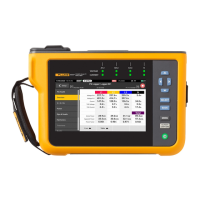1773/1775/1777
Calibration Manual
16
c. Sequentially set the calibrator to the voltages and frequencies in Tab l e 1 0 and check
that the Analyzer reading is between the limits.
Note
Use the DMM readings as reference with the 552xA calibrator.
5. Do this for all ranges in Ta b l e 1 0 :
a. Set the calibrator to supply a sine wave for all voltages.
b. Wait until each reading has stabilized.
The spreadsheet is the first choice for readings. Readings will have more resolution from
the spreadsheet.
Use the Calibration Tool for the RMS readings. Note that the instrument UI does not provide
the voltage transient RMS values.
If the Calibration Tool is not available, you can do manual readings:
1. Start a Logging session
2. Apply the voltages from Ta b l e 1 0 .
Be sure to wait at least 30 seconds between the test steps.
3. Download the measurement to Energy Analyze Plus software.
4. Go to PQ+ Study > Events.
5. Select the transient events and use the cursors on the transient waveform recordings to
identify the peak-to-peak voltage of the sine wave.
6. Calculate the RMS value by dividing the peak-to-peak reading by 2.8284.
7. When you are done, set the calibrator to Standby.
Current Measurement
Fluke recommends using a divider with 30 Ω across the Analyzer input and 10 kΩ in series with
high side of the input:
Fluke PN 2114858 (10 kΩ)
Fluke PN 1757740 (30 Ω) – see Tabl e 5 for the recommended assembly of this divider. Best
practice is to measure the resistor values at time of use.
Table 10. Transient Voltage Calibration
Calibration Output
Range Minimum Reading Maximum Reading
Voltage Frequency
1000 V 200 Hz ±8 kV 930 V 1070 V
600 V 10 kHz ±8 kV 550 V 650 V
200 V 100 kHz ±8 kV 170 V 230 V

